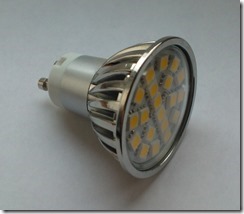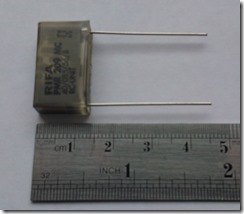Changing from Incandescent to LED Lighting
Posts on this blog are usually IT related so I thought it might make a change to write about something that, while still technology related, is a little different…
As some of my colleagues will attest to, I firmly believe in a well insulated house and buying products for the home that are as efficient as possible. My Home Server, for example, runs on a low power CPU in an effort to reduce the day-to-day running costs.
Many of our lights at home have already been converted to use CFL bulbs, replacing the original incandescent bulbs. I’m not a great fan of CFL bulbs however for a couple of reasons:
- The start-up time of some bulbs still seems to be long (not that that is necessarily an issue on a winter morning when I don’t want to be immediately blinded when switching the lights on)
- The bulbs contain mercury (albeit in small amounts); if you break a bulb, both the bulb and the items you use to clean up should be treated as hazardous waste (see http://archive.defra.gov.uk/environment/business/products/roadmaps/lightbulbs.htm for details)
On the plus side however, exchanging the incandescent bulbs for CFL ones has significantly reduced the number of bulbs I have to change. Our living room light, for example, used to need a bulb changing on average once per month as opposed to about once every 2-3 years for CFL bulbs. In addition, my (albeit approximate) calculations suggest that we save about £5-7 per bulb per year in energy costs, so in general the CFL bulbs pay for themselves within a few months.
Many of our new lights however use GU10 incandescent bulbs and while GU10 CFL bulbs are available, they are typically longer than the original incandescent bulbs and so will not fit in many of the housings (e.g. in spotlights etc.)
LED bulbs are however available and with recent improvements to LED technology, can now match the light output of the incandescent bulbs they replace. Even better, many of the GU10 LED replacements are exactly the same size as the original bulbs and are therefore direct replacements. I like LED bulbs for the following reasons:
- Fast start – LED lights are at full output almost immediately. In fact they beat an incandescent bulb, one of the reasons that they are used in brake lights on many cars these days
- ‘Warm white’ bulbs are now available. White LEDs always used to be ‘cold white’, i.e. showed a significant blue cast, making them a very harsh light. Great for some specific applications, but not so nice for everyday use. Dimmable bulbs are also available.
The bulbs I favour are as follows:
These have 20 SMD LEDs and produce a light output equivalent to a 50W incandescent. Hopefully if there are failures of the individual LEDs within the bulb, the failure will be gradual rather than suddenly stopping working completely, giving us time to source replacements.
I have, however, found an issue when replacing a set of incandescent GU10 bulbs with their LED equivalents. We replaced a set of 4 bulbs in a kitchen fitting with LED bulbs and found that when the lights were switched off, the bulbs still glowed gently. With a single incandescent bulb and 3 LED bulbs in the fitting, the issue didn’t occur. Following a little research, it became obvious that even with a properly earthed system, the capacitively coupled power from live to switched live is enough to cause an LED bulb to glow gently. With an incandescent bulb in the fitting, the resistance of this bulb was low enough to effectively absorb the leakage current and stop the LEDs from glowing.
There is a solution to the issue, which is to fit a resister-capacitor combination (a contact suppressant; not designed for this purpose, but works perfectly well) across the terminals of the light fitting. These can either be a DIY solution, but I have found a product recommended for this purpose, which is a combination 0.1uF capacitor and a 100 ohm resistor in a package suitable for use with 240V AC:
The link goes to a Farnell page, but I am sure that there are also available from other quality electronics resellers. There is also a 0.22uF version for longer circuits, should that be required. I’d strongly recommend using a bit of heat-shrink tubing on each lead of the package to ensure that the supply will not come in contact with the light casing.
Adding one of these devices to our kitchen light has completely solved the issue of the bulbs glowing even when switched off. The LED bulbs are saving something like 90% of the energy (and therefore the running costs) that would be consumed by incandescent bulbs and hopefully they will have a very long life span.

